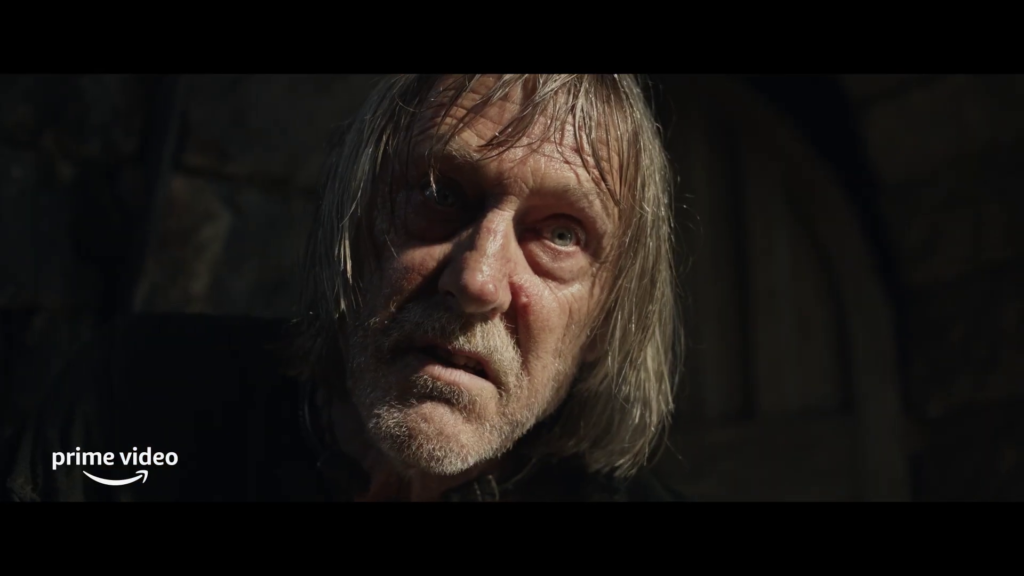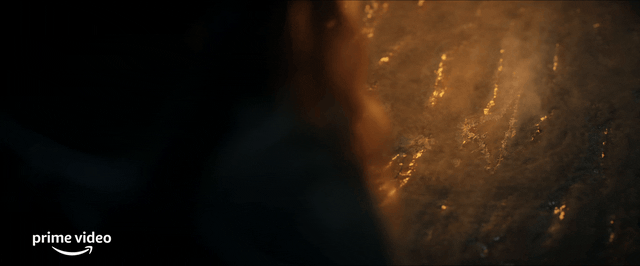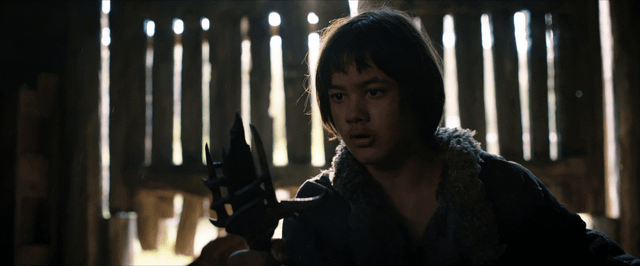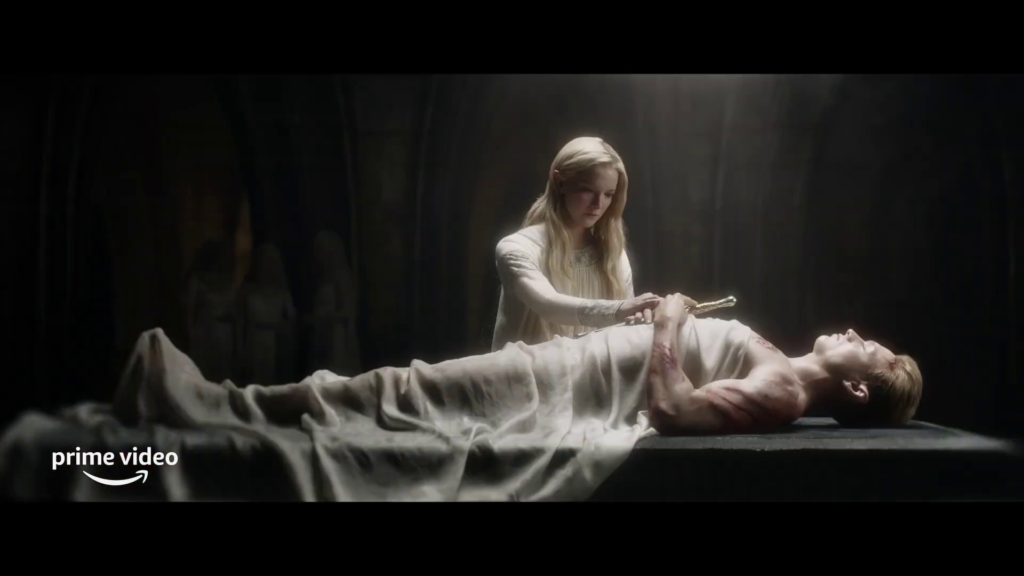‘But last night I told you of Sauron the Great, the Dark Lord. The rumours that you have heard are true: he has indeed arisen again and left his hold in Mirkwood and returned to his ancient fastness in the Dark Tower of Mordor. That name even you hobbits have heard of, like a shadow on the borders of old stories. Always after a defeat and a respite, the Shadow takes another shape and grows again.’
Gandalf, The Fellowship of The Ring by J.R.R. Tolkien

Fear has struck the hearts of Men as Sauron begins to stir again.
It is the Second Age of Middle-earth. The tide turns and evil reveals itself as a figure lurking in the shadows. Sauron is here. Albeit, invisible. His presence hinted at in the form of a searing hallmark.
Following the drop of the The Rings of Power trailer at the San Diego Comic-Con, Tolkien enthusiasts like myself have repeatedly pored over the SDCC trailer in search of elements from Tolkien’s lore buried within the scenes of the show. With the use of some deductive reasoning and observation, it is highly probable that we have uncovered a unique point in the lore, seemingly disguised as an icy mark.
The icy mark, in question, appears in two instances within the trailer. In the first instance, we see the mark actively of three spikes forming over a hard and stony surface. In the second, it distinctly appears on what can only be described as a forging anvil. A common factor in both instances is how the mark incorporates actively freezing water to reveal its runic features.
To fully understand how this icy rune may have formed, we must apply some deductive reasoning. Water is a substance that transforms into its crystalline state (ice) at freezing temperatures. The instant formation of ice often indicates temperatures much lower than freezing (sub-zero).
Looking at the scene from the trailer again, we see crystals of ice form rapidly upon the stony surface. If we take another step back, we can perhaps also draw another conclusion. This icy mark is not a mark made of rapidly freezing water, but rather by the lack of ice crystals in the space where the rune is inscribed. This indicates that the inscription or branding must have been made with a searingly hot implement such that ice has finely crystallized along its edges. It also appears the inscription continues to be indefatigably hot to boot.

Weighing these factors together, we can revise a couple points:
- The runes are in a location where sub-zero temperatures result in near-instance formation of ice crystals.
- The rune appears on an anvil — a tool used for forging weapons. Besides the trailer, we observe the same rune inscribed upon a broken sword held by Theo.
- If this rune is a maker’s mark of a master forger, what are the possible sources of the heated implement used to craft and forge weapons?
In Middle-earth, one location appears to be the optimal location for sub-zero temperature conditions. The Forodwaith is a frozen wasteland in the northern reaches of Middle-earth, which is also categorically home to Mount Gundabad (the northernmost tip of the Misty Mountains). While historically connected with the Dwarves, Gundabad is deeply contested by Orcs during the Second and Third Ages. While we have received no clarification from Amazon on the matter, the clues suggest Gundabad could be the place where these runes appear.
Given their active heat-emitting properties and its connection to the forging craft, we must now ask how such runes have come to exist in a place where there are no other obvious signs of active metallurgical hot working.
What could possibly be as hot as an active volcano to have inscribed a searingly hot rune into stone and metal in the coldest part of Middle-earth? How is the area of this rune still hot even (presumably), long after the mark was embedded in the anvil and the anvil was last used to forge things?
Could it be that these searing, tripartite* marks were made at the hands of Sauron?
‘What evil it saith I do not know; but I trace here a copy of it, lest it fade beyond recall. The Ring misseth, maybe, the heat of Sauron’s hand, which was black and yet burned like fire, and so Gil-galad was destroyed; and maybe were the gold made hot again, the writing would be refreshed.’
Isildur describing the Ring. The Council of Elrond, The Lord of the Rings

While it is ambiguous how Sauron brands any object with his mark, the heat of Sauron’s hand seems to be an obvious ultimate source of hot working temperatures for forging with various metals. Moreover, it is clear the signature on the anvil and the sword suggests the same Maker. That is, Sauron is involved in the creation of these objects.
But what is the purpose of the Mark? What is the purpose of a broken sword found at the bottom of a barn in the Southlands? Is it evidence of Sauron’s attempts to create an object that ensnares the will of another? The first of its kind. A Morgul-knife that shares characteristics similar to the Rings of Power?
If that were the case, Theo surely faces a dark future as the series unfolds episode by episode.
‘They tried to pierce your heart with a Morgul-knife which remains in the wound. If they had succeeded, you would have become like they are, only weaker and under their command. You would have became a wraith under the dominion of the Dark Lord; and he would have tormented you for trying to keep his Ring, if any greater torment were possible than being robbed of it and seeing it on his hand.’
Gandalf to Frodo. Many Meetings, The Lord of the Rings
Finally, if we presume this tripartite mark to be the definitive mark of Sauron’s invisible yet haunting presence on Middle-earth, I say that anything that touches it will turn to ash.

Bootnote: The design of the tripartite mark reveals some similarities to the Helm of Sauron in Peter Jackson’s Lord of the Rings films. Per WETA’s design, Sauron’s helm has six distinct points — three tall points spaced along the points of a triangle; then three shorter points towards the front. We see the tripartite mark on the anvil and on the blade Theo holds bears a resemblance to the configuration of the three points towards the front of Sauron’s helm.

Second bootnote!
It’s also worth drawing attention to a mark we can see on the left breast of Finrod’s body in the SDCC trailer. This mark appears to be an inverted form of Sauron’s mark, with the prongs pointing downward. The left and right prongs are distinct, while the elongated center one is more indistinct. It appears to have been burnt into the corpse, possibly posthumously.

A posthumously applied mark would preserve the Silmarillion canon of Finrod’s death in the dungeons of Sauron at the hands of a great werewolf (note the claw marks on the left bicep and forearm).
The question that continues to puzzle is how the body comes into the possession of Galadriel.
However, Beren and Luthien liberate many elven thralls from the dungeons of Sauron. The showrunners might be taking a tack where they return the body to Nargothrond (The Silmarillion states that Galadriel spent time there). Alternately, it may be that the scene occurs on Tol-in-Gaurhoth itself. The latter would preserve the integrity of Finrod’s burial, but at the risk of intruding Galadriel into the Beren and Luthien story. Of course, if the scene occurs in flashback, we may never even (or require) get the full context — if it doesn’t serve the story, it can be left to the imagination of watchers to fill in the blanks however they want.
* Editor’s note: we’re calling it a tripartite mark because of those three spikes. Also, just as we were about to go to “print” with this piece, Stephen Colbert showed this clip as part of an interview with Morfydd Clark on The Late Show With Stephen Colbert. Looks like we were on the money.
About the author: DrNosy is a scientist (physical science), scholar, and Tolkien enthusiast. Her primary interests lie in review and analysis of The Lord of the Rings: The Rings of Power. She is an active contributor and Reading Room Moderator on TheOneRing.net Discord where she also hosts live open-forum panel discussions on The Rings of Power, The Silmarillion, and a variety of Tolkien-related topics. You can reach her on Twitter.
Acknowledgements: All these GIFs and the Colbert clip are thanks to the hard work of our fab Discord member, WheatBix.


